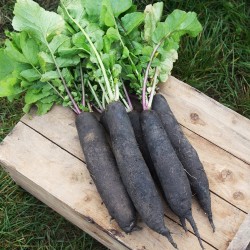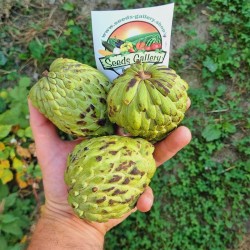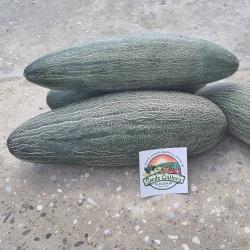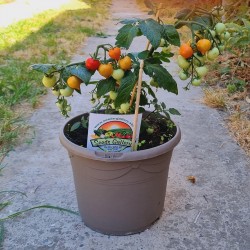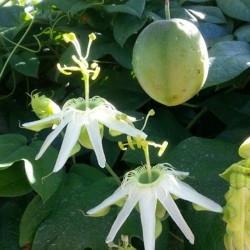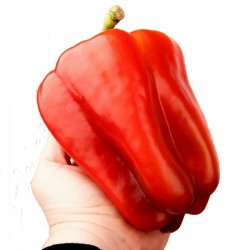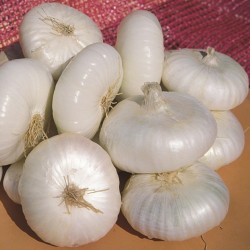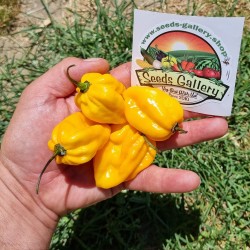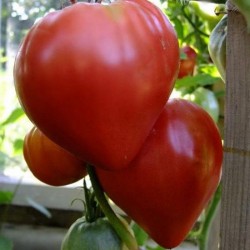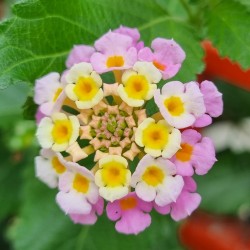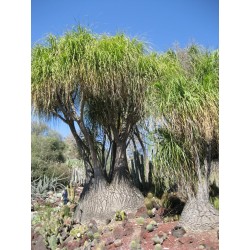Seeds Gallery Com,
5/
5
<h2 class=""><strong>Spanish flag seeds (Lantana camara)</strong><br><span style="color: #f80000;"><strong>Price for Package of 10 seeds</strong></span></h2>
<p style="color: #202122; font-size: 14px;"><i><b>Lantana camara</b></i><span> </span>(<b>common lantana</b>) is a species of flowering plant within the<span> </span>verbena<span> </span>family (Verbenaceae), native to the American tropics.<sup id="cite_ref-florida_5-0" class="reference" style="font-size: 11.2px;"></sup><sup id="cite_ref-moyhill_6-0" class="reference" style="font-size: 11.2px;"></sup><span> </span>Other common names of<span> </span><i>L. camara</i><span> </span>include<span> </span><b>Spanish flag</b>,<span> </span><b>big-sage</b><span> </span>(Malaysia),<span> </span><b>wild-sage</b>,<span> </span><b>red-sage</b>,<span> </span><b>white-sage</b><span> </span>(Caribbean),<span> </span><b>korsu wiri</b><span> </span>or<span> </span><b>korsoe wiwiri</b><span> </span>(Suriname),<span> </span><b>tickberry</b><span> </span>(South Africa),<sup id="cite_ref-Cronk_7-0" class="reference" style="font-size: 11.2px;">[7]</sup><span> </span><b>West Indian lantana</b>,<sup id="cite_ref-plants_8-0" class="reference" style="font-size: 11.2px;">[8]</sup><span> </span><b>umbelanterna</b>,<span> </span><b>putus</b><span> </span>in Bengal and<span> </span><b>Gu Phool</b><span> </span>in Assam, India.</p>
<p style="color: #202122; font-size: 14px;">As an ornamental,<span> </span><i>L. camara</i><span> </span>is often cultivated indoors, or in a conservatory, but can also thrive in a garden with sufficient shelter in cooler climates.<sup id="cite_ref-9" class="reference" style="font-size: 11.2px;">[9]</sup><span> </span>It has spread from its native Central and South America to around 50 countries,<sup id="cite_ref-Day_10-0" class="reference" style="font-size: 11.2px;">[10]</sup><span> </span>where it has become an<span> </span>invasive species.<sup id="cite_ref-Ghisalberti2000_11-0" class="reference" style="font-size: 11.2px;">[11]</sup><sup id="cite_ref-12" class="reference" style="font-size: 11.2px;">[12]</sup><span> </span>It first spread out of the Americas when it was brought to<span> </span>Europe<span> </span>by Dutch explorers and cultivated widely, soon spreading further into<span> </span>Asia<span> </span>and<span> </span>Oceania<span> </span>where it has established itself as a notorious weed, and in Goa it was introduced by the Portuguese.<sup id="cite_ref-Ghisalberti2000_11-1" class="reference" style="font-size: 11.2px;">[11]</sup></p>
<p style="color: #202122; font-size: 14px;"><i>L. camara</i><span> </span>can outcompete native species, leading to a reduction in<span> </span>biodiversity.<sup id="cite_ref-13" class="reference" style="font-size: 11.2px;">[13]</sup><span> </span>It can also cause problems if it invades agricultural areas as a result of its toxicity to<span> </span>livestock, as well as its ability to form dense<span> </span>thickets<span> </span>which, if left unchecked, can greatly reduce the<span> </span>productivity<span> </span>of farmland.</p>
<h2 style="color: #000000; font-size: 1.5em;"><span class="mw-headline" id="Description">Description</span></h2>
<p style="color: #202122; font-size: 14px;"><i>Lantana camara</i><span> </span>is a<span> </span>perennial, erect sprawling or<span> </span>scandent, shrub which typically grows to around 2 m tall and form dense thickets in a variety of environments. In the right conditions though, it can scramble up into trees and can grow to 6 metres tall.<span> </span>Due to extensive selective breeding throughout the 17th and 18th Centuries for use as an ornamental plant, there are now many different<span> </span><i>L. camara</i><span> </span>cultivars.<sup id="cite_ref-GISD_4-1" class="reference" style="font-size: 11.2px;"><br></sup></p>
<p style="color: #202122; font-size: 14px;"><i>L. camara</i><span> </span>has small tubular shaped<span> </span>flowers, which each have four<span> </span>petals<span> </span>and are arranged in clusters in terminal areas<span> </span>stems. Flowers come in many different colours, including red, yellow, white, pink and orange, which differ depending on location in inflorescences, age, and maturity.<sup id="cite_ref-17" class="reference" style="font-size: 11.2px;">[17]</sup><span> </span>The flower has a<span> </span>tutti frutti<span> </span>smell with a peppery undertone. After<span> </span>pollination<span> </span>occurs, the colour of the flowers changes (typically from yellow to orangish, pinkish, or reddish); this is believed to be a signal to<span> </span>pollinators<span> </span>that the pre-change colour contains a reward as well as being sexually viable, thus increasing pollination efficiency.<sup id="cite_ref-18" class="reference" style="font-size: 11.2px;">[18]</sup></p>
<p style="color: #202122; font-size: 14px;">The leaves are broadly ovate, opposite, and simple and have a strong odour when crushed.<sup id="cite_ref-19" class="reference" style="font-size: 11.2px;">[19]</sup></p>
<p style="color: #202122; font-size: 14px;">The fruit of<span> </span><i>L. camara</i><span> </span>is a berry-like drupe which turns from green to dark purple when mature. Green unripe fruits are inedible to humans and animals alike. Because of dense patches of hard spikes on their rind, ingestion of them can result in serious damage to the digestive tract. Both<span> </span>vegetative<span> </span>(asexual) and<span> </span>seed<span> </span>reproduction occur. Up to 12,000<span> </span>fruits<span> </span>can be produced by each plant<sup id="cite_ref-20" class="reference" style="font-size: 11.2px;">[20]</sup><span> </span>which are then eaten by birds and other animals which can spread the seeds over large distances, facilitating the spread of<span> </span><i>L. camara</i>.</p>
<h2 style="color: #000000; font-size: 1.5em;"><span class="mw-headline" id="Distribution">Distribution</span></h2>
<span style="color: #202122; font-size: 14px;">The native range of<span> </span></span><i style="color: #202122; font-size: 14px;">Lantana camara</i><span style="color: #202122; font-size: 14px;"><span> </span>is Central and South America; however, it has become naturalised in around 60 tropical and sub-tropical countries worldwide.</span><sup id="cite_ref-feppc2_21-0" class="reference" style="color: #202122; font-size: 11.2px;">[21]</sup><sup id="cite_ref-22" class="reference" style="color: #202122; font-size: 11.2px;">[22]</sup><span style="color: #202122; font-size: 14px;"><span> </span>It is found frequently in east and southern Africa, where it occurs at altitudes below 2000 m, and often invades previously disturbed areas such as<span> </span></span>logged<span style="color: #202122; font-size: 14px;"><span> </span>forests and areas cleared for agriculture.</span><br>
<p style="color: #202122; font-size: 14px;"><i>L. camara</i><span> </span>has also colonized areas of Africa, Southern Europe, such as Spain and Portugal, and also the Middle East, India, tropical Asia, Australia, New Zealand, and the US, as well as many Atlantic, Pacific and Indian Ocean islands.<sup id="cite_ref-24" class="reference" style="font-size: 11.2px;">[24]</sup><sup id="cite_ref-Thaman_25-0" class="reference" style="font-size: 11.2px;">[25]</sup><span> </span>It has become a significant weed in Sri Lanka after escaping from the<span> </span>Royal Botanic gardens<span> </span>in 1926.<sup id="cite_ref-fao_26-0" class="reference" style="font-size: 11.2px;">[26]</sup><sup id="cite_ref-27" class="reference" style="font-size: 11.2px;">[27]</sup></p>
<p style="color: #202122; font-size: 14px;">It was introduced into the Philippines from Hawaii as part of an exchange program between the United States and the Philippines; however, it managed to escape and has become naturalized in the islands.<sup id="cite_ref-28" class="reference" style="font-size: 11.2px;">[28]</sup><span> </span>It has also been introduced to the whole southern US, from<span> </span>California<span> </span>to<span> </span>North Carolina,<sup id="cite_ref-plants.usda.gov_29-0" class="reference" style="font-size: 11.2px;">[29]</sup><span> </span>and is considered hardy in USDA zones 10 and 11.<sup id="cite_ref-30" class="reference" style="font-size: 11.2px;">[30]</sup></p>
<p style="color: #202122; font-size: 14px;">The range of<span> </span><i>L. camara</i><span> </span>is still increasing, shown by the fact that it has invaded many islands on which it was not present in 1974, including the<span> </span>Galapagos Islands,<span> </span>Saipan<span> </span>and the<span> </span>Solomon Islands.<sup id="cite_ref-Thaman_25-1" class="reference" style="font-size: 11.2px;">[25]</sup><span> </span>There is also evidence that<span> </span><i>L. camara</i><span> </span>is still increasing its range in areas where it has been established for many years, such as East Africa, Australia and New Zealand.<sup id="cite_ref-Day_10-1" class="reference" style="font-size: 11.2px;">[10]</sup><span> </span>The ability of<span> </span><i>L. camara</i><span> </span>to rapidly colonise areas of land which have been disturbed has allowed it to proliferate in countries where activities such as logging, clearance for agriculture and<span> </span>forest fires<span> </span>are common. In contrast, in countries with large areas of intact primary forest, the distribution of<span> </span><i>L. camara</i><span> </span>has been limited.</p>
<h3 style="color: #000000; font-size: 1.2em;"><span class="mw-headline" id="Habitat">Habitat</span></h3>
<div class="thumb tright" style="color: #202122; font-size: 14px;">
<div class="thumbinner" style="font-size: 13.16px;"><img alt="" src="https://upload.wikimedia.org/wikipedia/commons/thumb/8/80/Lantana_camara-Silent_Valley-2016-08-14-001.jpg/220px-Lantana_camara-Silent_Valley-2016-08-14-001.jpg" decoding="async" width="220" height="147" class="thumbimage" srcset="//upload.wikimedia.org/wikipedia/commons/thumb/8/80/Lantana_camara-Silent_Valley-2016-08-14-001.jpg/330px-Lantana_camara-Silent_Valley-2016-08-14-001.jpg 1.5x, //upload.wikimedia.org/wikipedia/commons/thumb/8/80/Lantana_camara-Silent_Valley-2016-08-14-001.jpg/440px-Lantana_camara-Silent_Valley-2016-08-14-001.jpg 2x" data-file-width="6000" data-file-height="4000">
<div class="thumbcaption" style="font-size: 12.3704px;">
<div class="magnify"></div>
<i>L. camara</i><span> </span>in<span> </span>Silent Valley National Park,<span> </span>Kerala,<span> </span>India</div>
</div>
</div>
<p style="color: #202122; font-size: 14px;"><i>Lantana camara</i><span> </span>is found in a variety of environments, including:</p>
<ul style="color: #202122; font-size: 14px;">
<li>Agricultural areas</li>
<li>Forest margins and gaps</li>
<li>Riparian<span> </span>zones</li>
<li>Grasslands</li>
<li>Secondary forest, and</li>
<li>Beach fronts.</li>
</ul>
<p style="color: #202122; font-size: 14px;"><i>L. camara</i><span> </span>is rarely found in natural or semi-natural areas of forest, as it is unable to compete with taller trees due to its lack of tolerance for shade. Instead, it grows at the forest edge.<span> </span><i>L. camara</i><span> </span>can survive in a wide range of climatic conditions, including<span> </span>drought, different soil types, heat, humidity, and salt. It is also relatively fired tolerant and can quickly establish itself in recently burnt areas of forest.</p>
<h3 style="color: #000000; font-size: 1.2em;"><span class="mw-headline" id="Invasive_species">Invasive species</span></h3>
<div class="thumb tright" style="color: #202122; font-size: 14px;">
<div class="thumbinner" style="font-size: 13.16px;"><img alt="" src="https://upload.wikimedia.org/wikipedia/commons/thumb/4/4d/Lantana_camara_tree.jpg/220px-Lantana_camara_tree.jpg" decoding="async" width="220" height="316" class="thumbimage" srcset="//upload.wikimedia.org/wikipedia/commons/thumb/4/4d/Lantana_camara_tree.jpg/330px-Lantana_camara_tree.jpg 1.5x, //upload.wikimedia.org/wikipedia/commons/thumb/4/4d/Lantana_camara_tree.jpg/440px-Lantana_camara_tree.jpg 2x" data-file-width="891" data-file-height="1279">
<div class="thumbcaption" style="font-size: 12.3704px;">
<div class="magnify"></div>
6 metre tall<span> </span><i>L. camara</i><span> </span>shrubs infesting a native woodland area in<span> </span>Sydney.</div>
</div>
</div>
<p style="color: #202122; font-size: 14px;"><i>L. camara</i><span> </span>is considered to be a weed in large areas of the<span> </span>Paleotropics<span> </span>where it has established itself. In agricultural areas or secondary forests it can become the dominant understorey shrub, crowding out other native species and reducing biodiversity.<sup id="cite_ref-Cronk_7-2" class="reference" style="font-size: 11.2px;">[7]</sup><span> </span>The formation of dense thickets of<span> </span><i>L. camara</i><span> </span>can significantly slow down the regeneration of forests by preventing the growth of new trees.<sup id="cite_ref-GISD_4-2" class="reference" style="font-size: 11.2px;">[4]</sup></p>
<p style="color: #202122; font-size: 14px;">In the US,<span> </span><i>L. camara</i><span> </span>is considered invasive in tropical areas such as<span> </span>Florida<span> </span>and<span> </span>Hawaii.<sup id="cite_ref-plants.usda.gov_29-1" class="reference" style="font-size: 11.2px;">[29]</sup></p>
<p style="color: #202122; font-size: 14px;">Although<span> </span><i>L. camara</i><span> </span>is itself quite resistant to fire, it can change fire patterns in a forest<span> </span>ecosystem<span> </span>by altering the fuel load, causing a buildup of forest fuel, which itself increases the risk of fires spreading to the<span> </span>canopy.<sup id="cite_ref-33" class="reference" style="font-size: 11.2px;">[33]</sup><span> </span>This can be particularly destructive in dry, arid areas where fire can spread quickly and lead to the loss of large areas of natural ecosystem.</p>
<p style="color: #202122; font-size: 14px;"><i>L. camara</i><span> </span>reduces the productivity in pasture through the formation of dense thickets, which reduce growth of crops as well as make harvesting more difficult. There are also secondary impacts, including the finding that in Africa,<span> </span>mosquitos<span> </span>which transmit<span> </span>malaria<span> </span>and<span> </span>tsetse<span> </span>flies shelter within the bushes of<span> </span><i>L. camara</i>.<sup id="cite_ref-34" class="reference" style="font-size: 11.2px;">[34]</sup></p>
<p style="color: #202122; font-size: 14px;">Even though<span> </span><i>L. camara</i><span> </span>is considered invasive to the<span> </span>Western Ghats, the plant does not seem to impact biodiversity in the region; rather it tends to simply occupy the same moist regions as other species.<sup id="cite_ref-35" class="reference" style="font-size: 11.2px;">[35]</sup></p>
<p style="color: #202122; font-size: 14px;">There are many reasons why<span> </span><i>L. camara</i><span> </span>has been so successful as an invasive species; however, the primary factors which have allowed it to establish itself are:</p>
<ol style="color: #202122; font-size: 14px;">
<li>Wide dispersal range made possible by birds and other animals that eat its drupes</li>
<li>Less prone to being eaten by animals due to toxicity</li>
<li>Tolerance of a wide range of environmental conditions<sup id="cite_ref-Cronk_7-3" class="reference" style="font-size: 11.2px;">[7]</sup></li>
<li>Increase in logging and habitat modification, which has been beneficial to<span> </span><i>L. camara</i><span> </span>as it prefers disturbed habitats</li>
<li>Production of toxic chemicals which inhibit competing plant species</li>
<li>Extremely high seed production (12,000 seeds from each plant per year)<sup id="cite_ref-36" class="reference" style="font-size: 11.2px;">[36]</sup></li>
</ol>
<h3 style="color: #000000; font-size: 1.2em;"><span class="mw-headline" id="Toxicity">Toxicity</span></h3>
<div class="thumb tleft" style="color: #202122; font-size: 14px;">
<div class="thumbinner" style="font-size: 13.16px;"><img alt="" src="https://upload.wikimedia.org/wikipedia/commons/thumb/8/81/Lantana_camara_%2855%29.jpg/220px-Lantana_camara_%2855%29.jpg" decoding="async" width="220" height="146" class="thumbimage" srcset="//upload.wikimedia.org/wikipedia/commons/thumb/8/81/Lantana_camara_%2855%29.jpg/330px-Lantana_camara_%2855%29.jpg 1.5x, //upload.wikimedia.org/wikipedia/commons/thumb/8/81/Lantana_camara_%2855%29.jpg/440px-Lantana_camara_%2855%29.jpg 2x" data-file-width="600" data-file-height="399">
<div class="thumbcaption" style="font-size: 12.3704px;">
<div class="magnify"></div>
<i>L. camara</i></div>
</div>
</div>
<p style="color: #202122; font-size: 14px;"><i>Lantana camara</i><span> </span>is known to be toxic to livestock such as cattle, sheep, horses, dogs and goats.<sup id="cite_ref-37" class="reference" style="font-size: 11.2px;">[37]</sup><sup id="cite_ref-38" class="reference" style="font-size: 11.2px;">[38]</sup><span> </span>The active substances causing toxicity in grazing animals are<span> </span>pentacyclic<span> </span>triterpenoids, which result in liver damage and photosensitivity.<sup id="cite_ref-39" class="reference" style="font-size: 11.2px;">[39]</sup><span> </span><i>L. camara</i><span> </span>also excretes<span> </span>allelopathic<span> </span>chemicals, which reduce the growth of surrounding plants by inhibiting<span> </span>germination<span> </span>and root elongation.<sup id="cite_ref-40" class="reference" style="font-size: 11.2px;">[40]</sup></p>
<p style="color: #202122; font-size: 14px;">The toxicity of<span> </span><i>L. camara</i><span> </span>to humans is undetermined, with several studies suggesting that ingesting berries can be toxic to humans, such as a study by O P Sharma which states "Green unripe fruits of the plant are toxic to humans".<sup id="cite_ref-41" class="reference" style="font-size: 11.2px;">[41]</sup><span> </span>NC State's Extension Gardener website states that ingestion of the flowers, fruits, and leaves can cause vomiting, diarrhea, difficulty breathing, and liver failure, while the leaves can cause contact dermatitis.<sup id="cite_ref-42" class="reference" style="font-size: 11.2px;">[42]</sup><span> </span>However, other studies have found evidence which suggests that<span> </span><i>L. camara</i><span> </span>fruit poses no risk to humans when eaten, and is in fact edible when ripe.<sup id="cite_ref-43" class="reference" style="font-size: 11.2px;">[43]</sup><sup id="cite_ref-44" class="reference" style="font-size: 11.2px;">[44]</sup></p>
<h2 style="color: #000000; font-size: 1.5em;"><span class="mw-headline" id="Management_and_control">Management and control</span></h2>
<div class="thumb tright" style="color: #202122; font-size: 14px;">
<div class="thumbinner" style="font-size: 13.16px;"><img alt="Butterfly feeding on Lantana camara" src="https://upload.wikimedia.org/wikipedia/commons/thumb/e/e2/Graphium_sarpedon_WQXGA.jpg/220px-Graphium_sarpedon_WQXGA.jpg" decoding="async" width="220" height="138" class="thumbimage" srcset="//upload.wikimedia.org/wikipedia/commons/thumb/e/e2/Graphium_sarpedon_WQXGA.jpg/330px-Graphium_sarpedon_WQXGA.jpg 1.5x, //upload.wikimedia.org/wikipedia/commons/thumb/e/e2/Graphium_sarpedon_WQXGA.jpg/440px-Graphium_sarpedon_WQXGA.jpg 2x" data-file-width="2560" data-file-height="1600">
<div class="thumbcaption" style="font-size: 12.3704px;">
<div class="magnify"></div>
Butterfly feeding on<span> </span><i>L. camara</i></div>
</div>
</div>
<p style="color: #202122; font-size: 14px;">Effective management of invasive<span> </span><i>L. camara</i><span> </span>in the long term will require a reduction in activities that create degraded habitats. Maintaining functioning (healthy) ecosystems is key to preventing invasive species from establishing themselves and out-competing native<span> </span>fauna<span> </span>and<span> </span>flora.</p>
<h3 style="color: #000000; font-size: 1.2em;"><span class="mw-headline" id="Biological">Biological</span></h3>
<p style="color: #202122; font-size: 14px;">Insects and other<span> </span>biocontrol<span> </span>agents have been implemented with varying degrees of success in an attempt to control<span> </span><i>L. camara</i>. It was the first weed ever subjected to biological control; however, none of the programs have been successful despite 36 control agents being used across 33 regions.<sup id="cite_ref-Management_Information_45-0" class="reference" style="font-size: 11.2px;">[45]</sup></p>
<p style="color: #202122; font-size: 14px;">The lack of success using biological control in this case is most likely due to the many<span> </span>hybrid<span> </span>forms of<span> </span><i>L. camara</i>, as well as its large<span> </span>genetic diversity<span> </span>which makes it difficult for the control agents to target all plants effectively. A recent study in India has shown some results around biological control of this plant using tingid bugs.<sup id="cite_ref-46" class="reference" style="font-size: 11.2px;">[46]</sup></p>
<h3 style="color: #000000; font-size: 1.2em;"><span class="mw-headline" id="Mechanical">Mechanical</span></h3>
<p style="color: #202122; font-size: 14px;">Mechanical control of<span> </span><i>L. camara</i><span> </span>involves physically removing the plants. Physical removal can be effective but is labor-intensive and expensive,<span> </span>therefore removal is usually only appropriate in small areas or at the early stages of an infestation. Another method of mechanical control is to use fire treatment, followed by revegetation with native species.</p>
<h3 style="color: #000000; font-size: 1.2em;"><span class="mw-headline" id="Chemical">Chemical</span></h3>
<p style="color: #202122; font-size: 14px;">Using herbicides to manage<span> </span><i>L. camara</i><span> </span>is very effective but also expensive, prohibiting its use in many poorer countries where<span> </span><i>L. camara</i><span> </span>is well established. The most effective way of chemically treating plant species is to first mow the area, then spray the area with a<span> </span>weed-killer, although this may have serious environmental consequences.</p>
<h2 style="color: #000000; font-size: 1.5em;"><span class="mw-headline" id="Uses">Uses</span></h2>
<div class="thumb tright" style="color: #202122; font-size: 14px;">
<div class="thumbinner" style="font-size: 13.16px;"><img alt="Butterfly resting on L. camara" src="https://upload.wikimedia.org/wikipedia/commons/thumb/2/2e/Butterfly_on_Lantana_-_Flickr_-_Andrea_Westmoreland.jpg/220px-Butterfly_on_Lantana_-_Flickr_-_Andrea_Westmoreland.jpg" decoding="async" width="220" height="156" class="thumbimage" srcset="//upload.wikimedia.org/wikipedia/commons/thumb/2/2e/Butterfly_on_Lantana_-_Flickr_-_Andrea_Westmoreland.jpg/330px-Butterfly_on_Lantana_-_Flickr_-_Andrea_Westmoreland.jpg 1.5x, //upload.wikimedia.org/wikipedia/commons/thumb/2/2e/Butterfly_on_Lantana_-_Flickr_-_Andrea_Westmoreland.jpg/440px-Butterfly_on_Lantana_-_Flickr_-_Andrea_Westmoreland.jpg 2x" data-file-width="5098" data-file-height="3618">
<div class="thumbcaption" style="font-size: 12.3704px;">
<div class="magnify"></div>
Butterfly resting on<span> </span><i>L. camara</i></div>
</div>
</div>
<p style="color: #202122; font-size: 14px;"><i>Lantana camara</i><span> </span>stalks have been used in the construction of furniture, such as chairs and tables;<span> </span>however, the main uses have historically been medicinal and ornamental.</p>
<h3 style="color: #000000; font-size: 1.2em;"><span class="mw-headline" id="Medicinal_value">Medicinal value</span></h3>
<p style="color: #202122; font-size: 14px;">Studies conducted in India have found that<span> </span><i>Lantana</i><span> </span>leaves can display<span> </span>antimicrobial,<span> </span>fungicidal,<span> </span>and<span> </span>insecticidal<span> </span>properties.<span> </span><i>L. camara</i><span> </span>has also been used in traditional herbal medicines for treating a variety of ailments, including<span> </span>cancer, skin itches,<span> </span>leprosy,<span> </span>chickenpox,<span> </span>measles,<span> </span>asthma,<span> </span>and<span> </span>ulcers.<sup id="cite_ref-GISD_4-4" class="reference" style="font-size: 11.2px;">[4]</sup></p>
<p style="color: #202122; font-size: 14px;"><i>L. camara</i><span> </span>extract has been shown to reduce gastric<span> </span>ulcer<span> </span>development in rats.<sup id="cite_ref-49" class="reference" style="font-size: 11.2px;">[49]</sup><span> </span>Extracts from the plant have also been used in Brazil to treat respiratory infections.<sup id="cite_ref-50" class="reference" style="font-size: 11.2px;">[50]</sup></p>
<h3 style="color: #000000; font-size: 1.2em;"><span class="mw-headline" id="Ornamental">Ornamental</span></h3>
<p style="color: #202122; font-size: 14px;"><i>Lantana camara</i><span> </span>has been grown specifically for use as an ornamental plant since Dutch explorers first brought it to Europe from the New World.<sup id="cite_ref-GISD_4-5" class="reference" style="font-size: 11.2px;">[4]</sup><span> </span>Its ability to last for a relatively long time without water, and the fact that it does not have many pests or diseases which affect it, have contributed to it becoming a common ornamental plant.<span> </span><i>L. camara</i><span> </span>also attracts butterflies and birds and is frequently used in butterfly gardens.<sup id="cite_ref-florida_5-1" class="reference" style="font-size: 11.2px;">[5]</sup></p>
<h3 style="color: #000000; font-size: 1.2em;"><span class="mw-headline" id="As_a_host-plant">As a host-plant</span></h3>
<p style="color: #202122; font-size: 14px;">Many butterfly species feed on the nectar of<span> </span><i>L. camara.</i><span> </span><i>Papilio homerus</i>, the largest butterfly in the western hemisphere, is known to feed on the nectar of the flowers as an opportunistic flower feeder.<sup id="cite_ref-51" class="reference" style="font-size: 11.2px;">[51]</sup><span> </span>A jumping spider<span> </span><i>Evarcha culicivora</i><span> </span>has an association with<span> </span><i>L. camara</i>. They consume the nectar for food and preferentially use these plants as a location for courtship.<sup id="cite_ref-:2_52-0" class="reference" style="font-size: 11.2px;">[52]</sup></p>
<h2 style="color: #000000; font-size: 1.5em;"><span class="mw-headline" id="Etymology">Etymology</span></h2>
<p style="color: #202122; font-size: 14px;">The name<span> </span><i>Lantana</i><span> </span>derives from the<span> </span>Latin<span> </span>name of the wayfaring tree<span> </span><i>Viburnum lantana</i>, the flowers of which closely resemble<span> </span><i>Lantana</i>.<sup id="cite_ref-Ghisalberti2000_11-2" class="reference" style="font-size: 11.2px;">[11]</sup><sup id="cite_ref-gledhill_53-0" class="reference" style="font-size: 11.2px;">[53]</sup></p>
<p style="color: #202122; font-size: 14px;"><i>Camara</i><span> </span>is derived from<span> </span>Greek, meaning ‘arched’, ‘chambered’, or ‘vaulted’.</p>
<br>
<script src="//cdn.public.n1ed.com/G3OMDFLT/widgets.js"></script>
MHS 59 (10 S)





